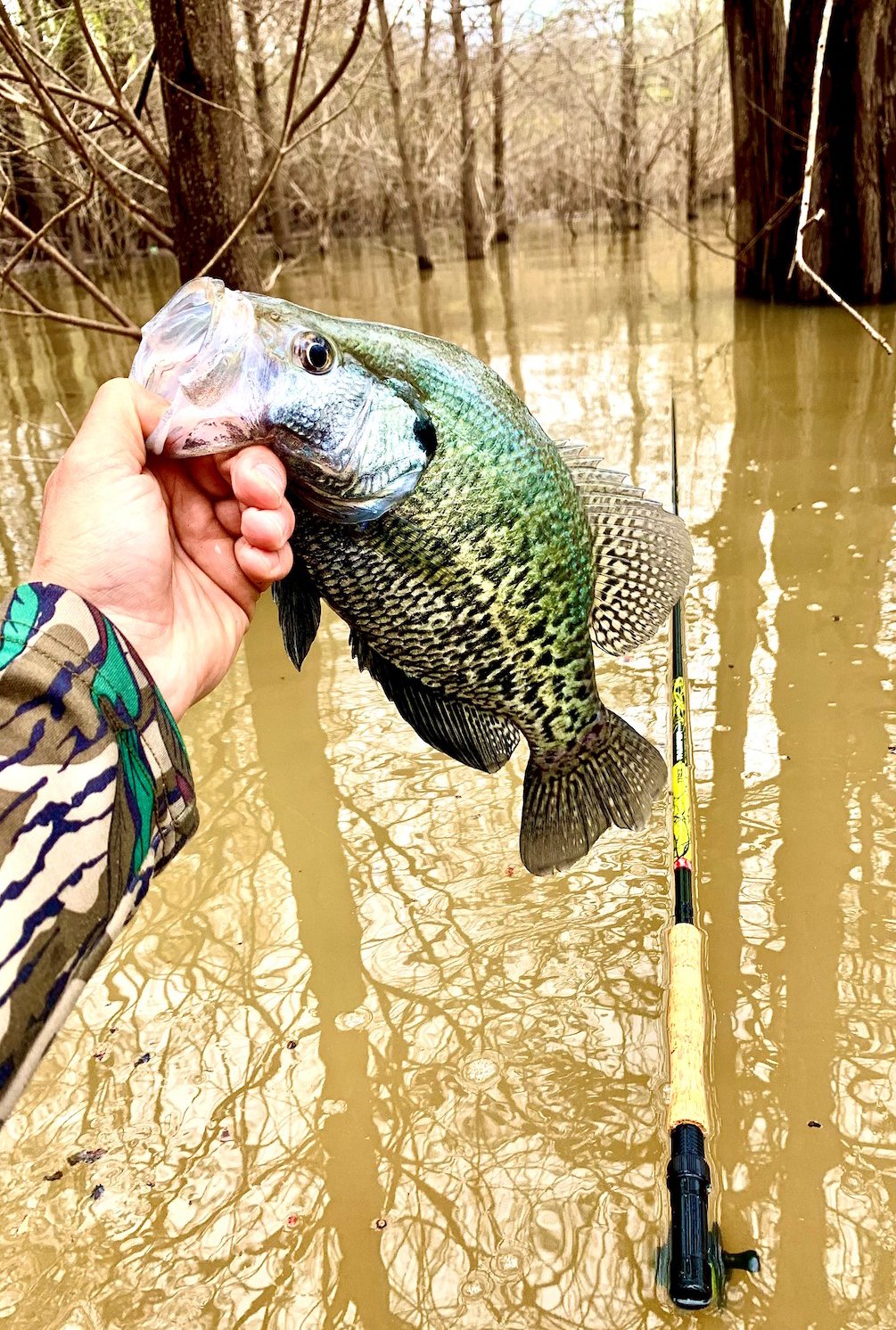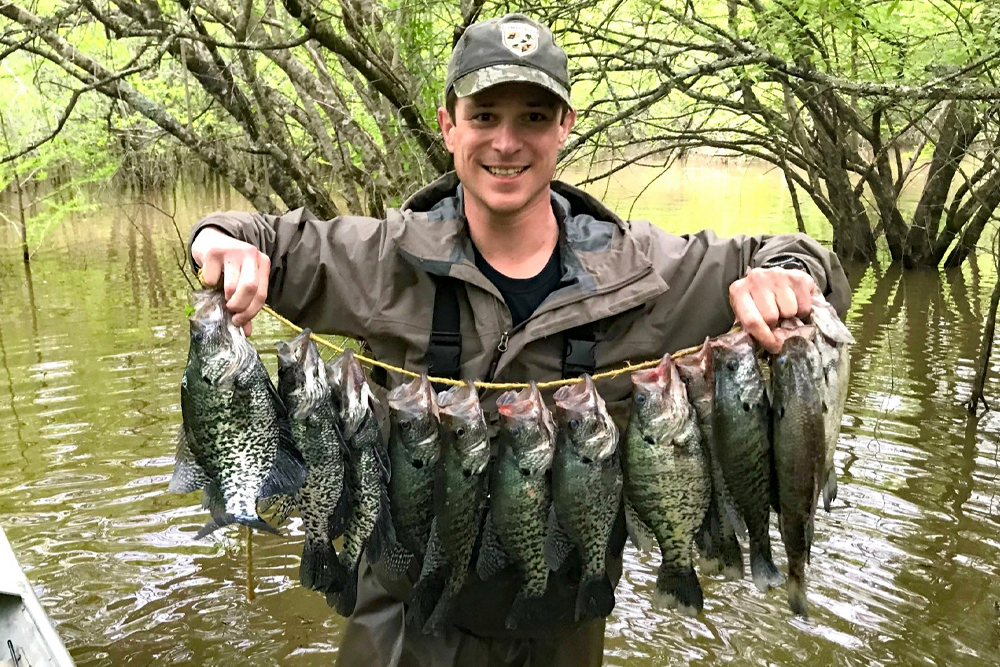Wesley Montgomery of Starkville, Mississippi hoists a dandy stringer of crappie caught wade fishing flooded backwaters in North Mississippi in the springtime.
North Mississippi Wade Fishing
by John David Santi
Spring time thumps in the Magnolia State
Nearly everyone agrees, the state of Mississippi hosts some of the finest crappie fishing in North America. It is no secret that the I-55 chain of the U.S. Corp in Engineer flood control reservoirs (Arkabutla, Sardis, Enid, Grenada Lake) produce hefty stringers of fish each year.
Most anglers ply their trade from a boat, spider rigging flooded timber, creek channels and flats. However, a select few anglers prefer another more “up close and personal” approach – wading the shallow waters during the crappie spawn.

As spring time water temperatures reach the upper 50s and into the 60s crappies begin their yearly commute into shallow flood waters to begin the annual ritual to create more crappie. These fish follow drainages and tributaries from the main lake up into the shallows. The best approach for getting into the thick and tangled flooded forests where they spawn is simply with a pair of waders.
Crappie prefer to spawn on a hard bottom near or around cover such as cypress trees, buck brush, hardwood trees, stumps, and vines. Cypress trees have a vast root system that are great cover for spawning fish, and are a great indicator that you’re in a good area that could potentially hold fish. These flooded forests can often be reached on foot, or with the aid of a small jon boat, kayak, or ATV to help get off the beaten path and back into some untouched fishing areas.
When searching for potential fishing locations I prefer to begin by scouring satellite and topo imagery to locate tributaries or smaller feeder creeks that lead up into flooded areas. As early spring time water temperatures hit that magical number, fish will move further up these tributaries and flooded areas into shallower water. Once you’ve located a potential spot, I start by wading shallow cover and working my way into deeper water to find fish.
Crappie will hold in water as shallow as your ankles, but knee to waist deep seems to be a common depth to find these tasty fish. Walking slowly from spot to spot and into the wind will help in not spooking fish and mudding up the water around cover.

Wade fishing guru, Wesley Montgomery of Starkville, Mississippi has been wade fishing crappie in the north Mississippi reservoirs since he could sport a pair of waders. It is a family tradition that has been passed down through two generations. Over the years he has compiled a list of key factors to consider when searching for spawning crappie.
“Perfect water temperature, consecutive days of stable lake levels, and 1-2 inches of visibility are the ideal conditions for crappie to move into shallow cover,” he said. “Once you find fish, stay at the same water depth, and move even slower through the cover, fishing everything methodically. Recognizing if it is a high water, or low water year in the lake you plan to fish is crucial. During high water years the fish can move deep into nasty thick cover making them tougher to locate. In low water years they stick to more obvious cover. If you catch a fish off a tree, stay still, let things settle down for a few minutes, and drop your jig on the same tree. It is very likely there are more fish there.”
A complementing factor to wade fishing is that it only requires one pole to get out on the water, making it a rather inexpensive avenue into the world of crappie fishing. Through trial and error, I have come to prefer a 2 piece, 10 foot B’nM tree thumper for my do-all wade fishing rod. The 2-piece rod gives the ability to break the rod down to more easily walk-through thick brush. and the length allows you to reach the fish without spooking them. A ten-foot rod gives you enough backbone to set the hook and get fish out of cover quickly.

There are many different options to choose from for a reel; spinning, underspin, push button style reels, all can get the job done. An ultralight crappie reel is my reel of preference, keeping things light and simple. The drag system on this style of reel allows for easy line depth adjustments in shallow or deeper water. Because these crappie are normally surrounded by dense cover, it is wise to use 6-8 pound test line to hoist the fish out into the open. Fluorocarbon and monofilament are ideal for this style of jigging.
Crappie jigs come in all shapes, forms, and sizes, and it can be difficult to narrow down a bait of choice. For these Mississippi reservoirs I like to tie on color combinations such as orange/chartreuse, black/chartreuse, and pink/chartreuse. Don’t be afraid to change up colors throughout the day when searching for fish. A larger size bait, such as the Bobby Garland 3” Slab Slay’R seems to cut down on the number of short fish caught. A larger profile bait will generally yield bigger fish in this circumstance. A 1/16 ounce jig head fits the profile of a 3 inch bait perfect.
In order to get your bait deep into cover, it is common practice to pull 12-18 inches of line from the end of the rod, use one hand to pull the jig to the very tip of the rod and gently lower the jig into the water. This method keeps the jig from getting hung up and allows the lure to be placed right in the strike zone.
“Once you find fish, stay at the same water depth, and move even slower through the cover, fishing everything methodically.” – Wesley Montgomery, Avid Crappie Wade Fisherman
The spring time in Mississippi is vibrant with life and is a beautiful time to be out on the water. Wade fishing provides some of the hottest action of the year in a manner that is uniquely simple but extremely effective. The aggressive thump of a shallow crappie will keep you coming back for more, year after year.
Learn more about wade fishing Lake Grenada in this video [HOTLINK TO THIS MONTH’S: CrappieNOW “How to” Video: Wading Grenada]
(John David Santi was born and raised in the midsouth just a stone’s throw away from the crappie rich waters of Mississippi. While attending the University of Mississippi, Santi was able to hone his crappie wade fishing skills. He now resides just outside of Jackson, Wyoming as a full time fly fishing guide.”


